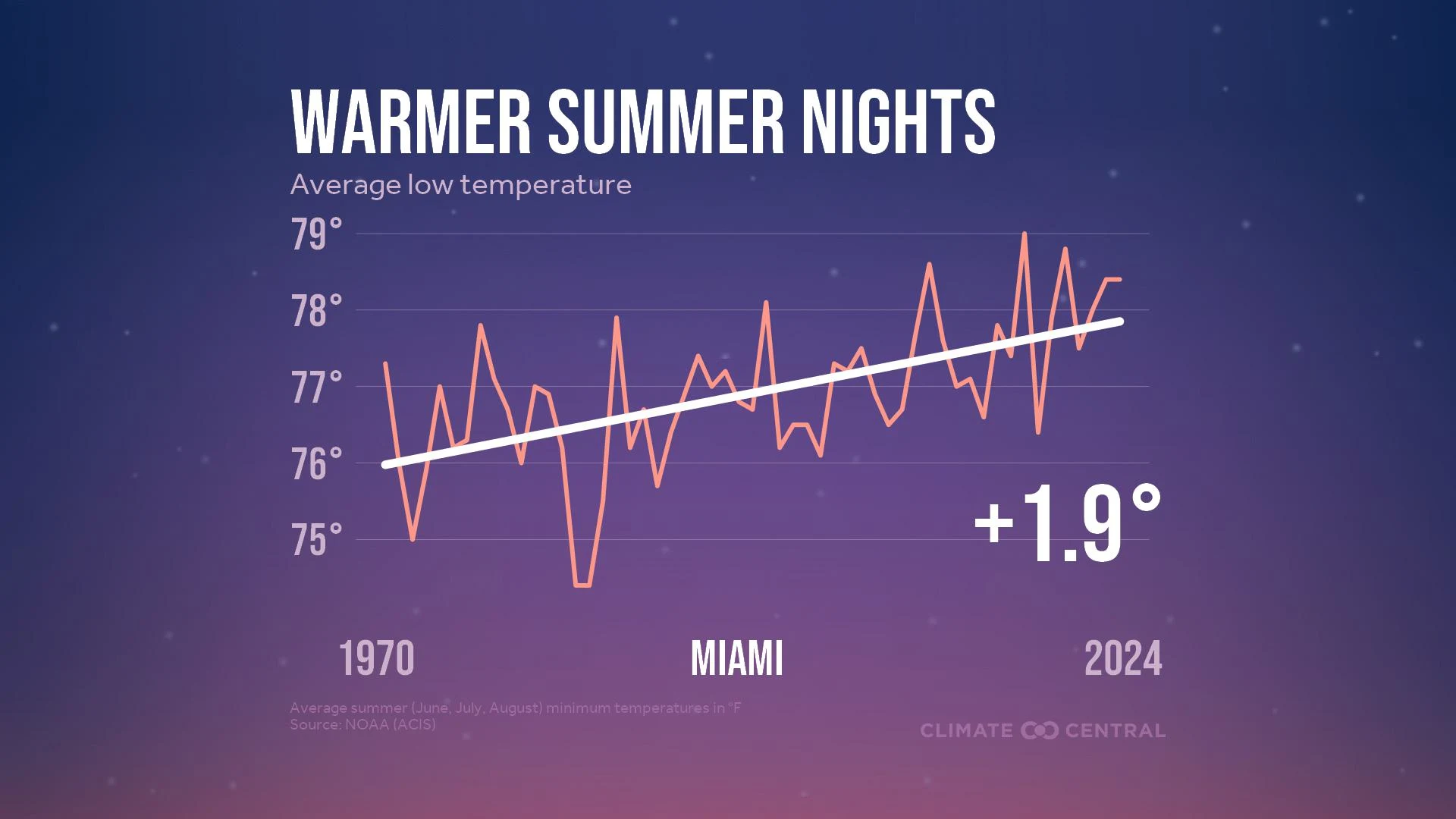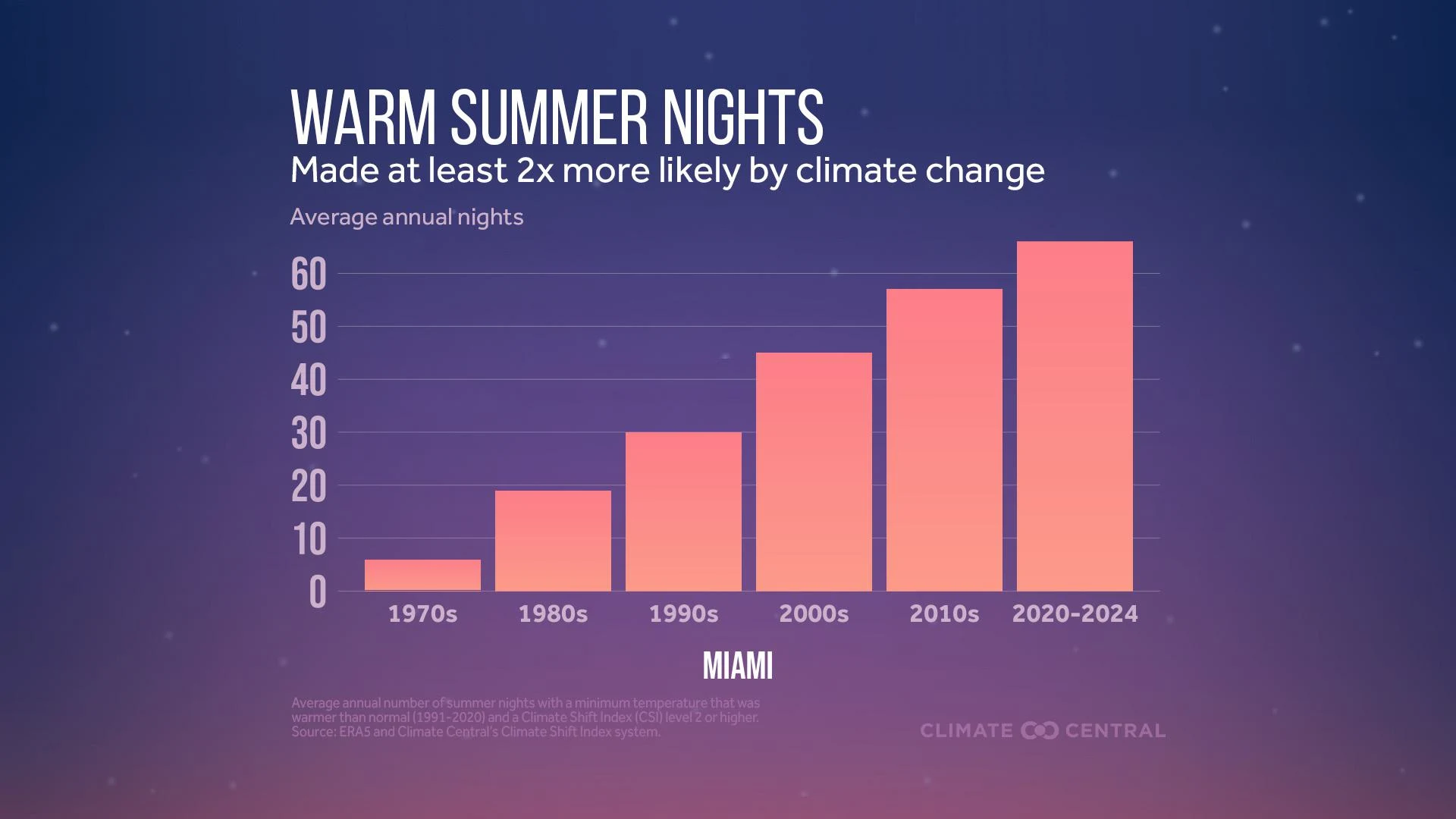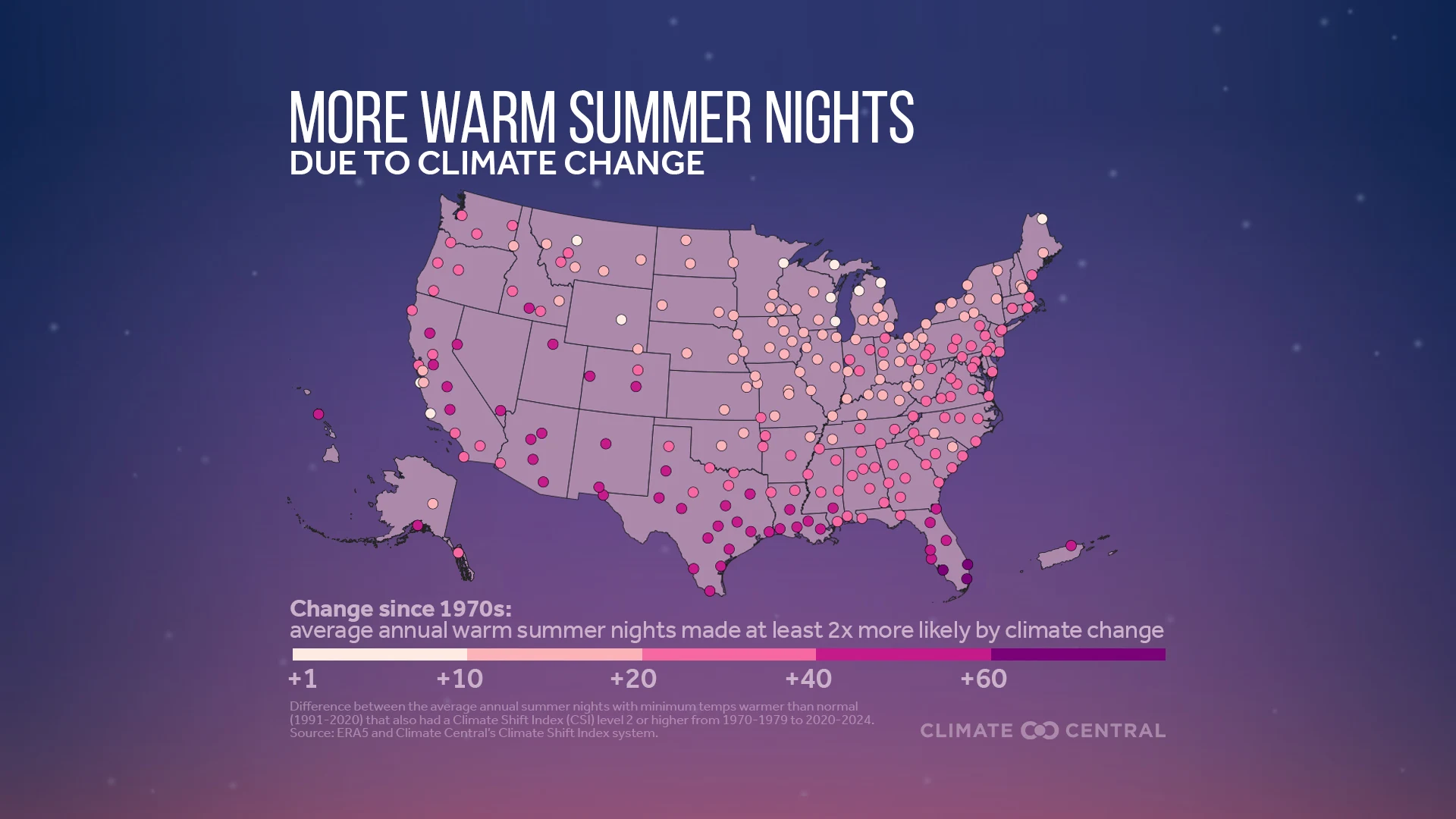Climate Matters•June 11, 2025
Warm Summer Nights Influenced by Climate Change
KEY FACTS
Since 1970, average summer minimum (nighttime) temperatures have warmed in 231 U.S. locations analyzed by Climate Central — by 3.1°F on average.
New analysis shows that climate change is having a growing influence on the frequency of sweltering summer nights since 1970 in all but one of the 247 major U.S. cities analyzed.
On average, these cities currently experience about 27 warmer-than-normal summer nights with a strong climate change fingerprint each year, compared to one such day annually during the 1970s.
The top five cities with the largest increases in climate change-fueled warm summer nights are all in Florida.
Hot summer nights limit our ability to cool off and recover from extremely hot summer days. This can lead to greater heat stress and related health risks.
This Climate Matters analysis is based on open-access data from the National Oceanic and Atmospheric Administration (NOAA). See Methodology for details.
Download local data
Sweltering nights in a warming world
As our climate warms, summer is heating up across the U.S. Summer warming isn’t all about scorching days — it’s also about sweltering nights.
When nights don’t cool off enough relative to peak daytime temperatures, people have a harder time cooling off. Heat is the deadliest weather-related hazard in the U.S., and warm nights can worsen heat stress and related health risks during the hottest time of year.

Summer nights heating up across the country
Climate Central analyzed average summer minimum (nighttime) temperatures from 1970 to 2024 in 241 U.S. locations (see Methodology). Since 1970, summer nighttime temperatures have warmed in 231 (96%) of these cities — by 3.1°F on average.
Regionally, summer nights have warmed the most since 1970 in the Southwest, where summer nights have warmed by 4.5°F on average across 11 locations.
Locations that experienced the most summer nighttime warming since 1970 were: Reno, Nev. (17.7°F); Las Vegas, Nev. (10°F); El Paso, Texas (8.9°F); Salt Lake City, Utah (8.2°F); Tyler, Texas (7.8°F); Boise, Idaho (7.6°F); and Medford, Ore. (7.4°F).

Fingerprints of climate change on summer nighttime heat
New analysis using Climate Central’s Climate Shift Index (CSI) directly assessed the influence of human-caused climate change on sweltering summer nights across the U.S. every year since 1970.
This analysis calculated the average annual number of warmer-than-normal summer nights that were strongly influenced by climate change (CSI level 2 or higher) each decade since 1970 in 247 major U.S. cities (see Methodology).
A CSI level 2 indicates local temperatures that were made at least two times more likely due to climate change.
Here, warmer-than-normal summer nights are defined as days with a minimum temperature warmer than the 1991-2020 nighttime normal temperature for a given location.

Climate change fueling warm summer nights in the U.S.
Since 1970, nearly all U.S. cities analyzed (246 out of 247) have experienced an increase in the frequency of warmer-than-normal summer nights with a strong climate change fingerprint.
On average, each year these cities currently experience about 27 warmer-than-normal summer nights with a CSI level 2 or higher. In comparison, these same cities used to experience an average of one such night each summer in the 1970s.
The top five cities with the largest increases in warmer-than-normal summer nights with a strong influence of climate change are in Florida: West Palm Beach (62); Ft. Myers (61); Miami (60); Tampa (59); and Orlando (58).
Sleepless Nights, a 2024 report from Climate Central, quantifies the influence of human-caused climate change on the frequency of hot summer nights globally.
Health risks from nighttime heat
Sweltering nights limit our ability to cool off and recover from hot summer days. This can lead to greater heat stress and related health risks — especially among people with chronic illness, young children, pregnant people, the elderly, weather-exposed workers, and other heat-vulnerable populations.
These risks compound when extremely hot days and nights occur back-to-back. Heat-related health risks can be higher in historically cooler climates, where people are less accustomed to these events, and in urban heat islands.
Structural inequities can lead to higher urban heat exposure for some communities. According to a 2021 study, people of color and those living below the poverty line are disproportionately exposed to urban heat extremes in 169 of the largest U.S. cities.
More warm nights also mean higher demand for air conditioning, which is less accessible to low-income households. A 2024 Climate Central analysis found that 231 U.S. locations have experienced rising cooling demands since 1970 due to rising temperatures.
LOCAL STORY ANGLES
Is climate change influencing daily heat extremes in your local area?
Climate Central’s Climate Shift Index system provides tools, data, custom maps, and local alerts to answer this question in real-time. Here are three ways to use the Climate Shift Index this summer:
Use the tools. Climate Central’s Climate Shift Index map tool shows which parts of the world are experiencing high Climate Shift Index levels, every day.
Access KML to create custom Climate Shift Index maps. Fill out this form to receive CSI maps in KML format, and create custom Climate Shift Index maps.
Sign up for alerts. Sign up here to receive custom email alerts when strong Climate Shift Index levels are detected in your local area.
How is extreme heat affecting public health in your local area?
The National Integrated Heat Health Information System HEAT.gov is a hub for information to support heat resilience in the U.S. Check out HeatRisk, an interactive map tool from the National Weather Service now available for the contiguous U.S. This color-numeric index shows current and forecast risk of daily local heat-related impacts. The CDC’s Heat and Health Tracker maps daily rates of heat-related illnesses across the U.S.
FIND EXPERTS
Submit a request to SciLine from the American Association for the Advancement of Science or to the Climate Data Concierge from Columbia University. These free services rapidly connect journalists to relevant scientific experts.
Browse maps of climate experts and services at regional NOAA, USDA, and Department of the Interior offices.
Explore databases such as 500 Women Scientists, BIPOC Climate and Energy Justice PhDs, and Diverse Sources to find and amplify diverse expert voices.
Reach out to your State Climate Office or the nearest Land-Grant University to connect with scientists, educators, and extension staff in your local area.
METHODOLOGY
Average annual summer (June, July, August) minimum temperatures trends from 1970-2024 were computed using a mathematical linear regression on data from the Applied Climate Information System, which is developed, maintained, and operated by NOAA’s Regional Climate Centers. While Climate Central's local analyses typically include 247 U.S. stations, data summaries are based on 241 stations due to data gaps in Bend, Ore.; Hazard, Ky.; Jefferson City, Mo.; Twin Falls and Idaho Falls, Idaho; and Wheeling, W.Va.
Daily summer minimum temperatures and Climate Shift Index (CSI) levels were obtained for 247 cities from 1970-2024. A warmer-than-normal summer night that was strongly influenced by climate change is defined as any day that had both:
a minimum temperature warmer than the 1991-2020 nighttime normal temperature for a given location, and
a CSI level of 2 or higher, which means that the minimum temperature that day was made at least twice as likely due to climate change
The total number of warmer-than-normal summer nights with a strong climate change influence was calculated for each year. Annual totals for each city were averaged over each decade and rounded to the nearest whole number. Note the 2020s include only the five years from 2020-2024.
The analysis is based on gridded temperature data from ERA5 and Climate Central’s Climate Shift Index. See the frequently asked questions for details on computing the Climate Shift Index, including a summary of the multi-model approach described in Gilford et al. (2022).

